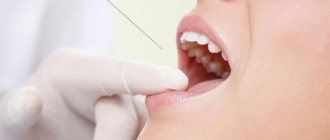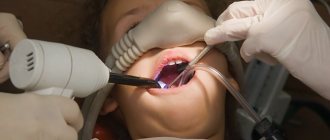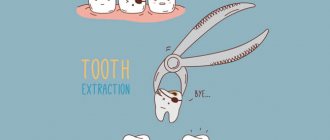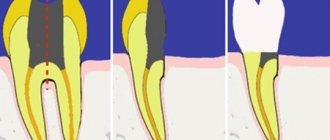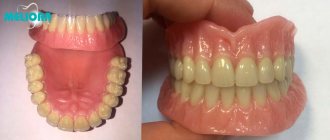Nowadays, with many safe anesthetic drugs available, the use of general anesthesia for dental treatment or extraction may seem excessive. However, it allows you to carry out any procedure - treatment, tooth extraction, restoration of fillings or sanitation of the oral cavity - completely painlessly. Many people still choose to have teeth removed under general anesthesia. Be that as it may, the choice of anesthesia method remains with the patient; the doctor’s duty in this case is to give the patient information about the advantages and consequences of each method.
What types of pain relief are used during tooth extraction?
A classic example of an archaic tooth extraction without any anesthesia is an episode from Chekhov’s story “Surgery.” In modern dentistry, such outright torture does not happen, and tooth extraction without anesthesia is not carried out under any circumstances. If it is necessary to remove 1 - 2 teeth in one visit, the operation is carried out mainly under local anesthesia. However, there are indications for tooth extraction under general anesthesia.
In medicine, the term “general anesthesia” means a state of inhibition of the central nervous system with a temporary immersion of the patient into sleep of varying degrees of depth and loss of pain sensitivity. This reaction of the body is artificially induced using safe anesthetic medications, and it lasts from 30 minutes to 3 hours, depending on the required volume of surgical intervention. For example, removing 4 wisdom teeth under general anesthesia will require a significant amount of time.
Contraindications to general anesthesia
We have to admit that this method of anesthesia cannot always be used; there are also contraindications, among which the following should be highlighted:
- pregnancy;
- chronic heart disease;
- diabetes mellitus and other types of endocrine system diseases;
- drug or alcohol intoxication of the patient;
- bronchial asthma.
A prerequisite for general anesthesia is that it should not last more than three hours. After this time, the doctor must stop the treatment, and it can be resumed only after 2-3 weeks.
Advantages of tooth extraction under general anesthesia
- Anesthesia slows down the body's reactions, due to which the pain is completely relieved. Therefore, all the dentist’s procedures for removing teeth will be completely painless for you.
- Many sensitive patients put off visiting a surgeon until dangerous complications develop simply because they are afraid of the mere sight of surgical instruments. If teeth are removed under general anesthesia, you will not see how the process will occur, but will only wake up when it is over.
- Even for a psychologically stable person, tooth extraction is a stressful situation that negatively affects the body. For example, patients often experience increased blood pressure during this procedure. However, if the operation is performed under general anesthesia, your nerves will not be damaged.
- While the anesthesia is in effect, the dentist will remove the necessary teeth and perform the necessary manipulations, which could take several visits. He will perform all actions carefully and efficiently, which will reduce the risk of complications.
Interesting fact!
According to data from various media sources, at least 2% of adults and 6 - 8% of children, for various reasons, do not have the opportunity to undergo routine tooth extraction using local anesthesia.
Possible complications
Some of the most common negative consequences of general anesthesia include the following:
- increased heart rate;
- tachycardia;
- convulsions;
- increased blood pressure;
- dysfunction of the respiratory system;
- vomiting reflex;
- laryngeal stenosis;
- bronchospasms;
- short-term memory problems.
It should be noted that such reactions occur only in a small number of patients; most feel well after surgery. In our clinics, general anesthesia is not used.
Types of anesthesia for tooth extraction and methods of its behavior
Based on the depth of anesthesia, anesthesia is divided into the following types:
- surface;
- easy;
- full;
- super deep.
For dental treatment under anesthesia, only superficial and light anesthesia is used in dentistry. While the last two types are used for complex operations, for example, for maxillofacial injuries.
Anesthesia is carried out in two main ways:
- inhalation - you inhale sprayed particles of the drug through a special mask;
- intravenously - using a regular injection.
High-quality anesthetic drugs promote restful drug-induced sleep and recovery from it without any complications. Modern anesthetic medications are highly safe and suitable even for patients with allergies. They do not cause side effects or addiction and are easily eliminated from the body.
Indications for removal
Medical indications can be divided into 4 main groups.
- Crowding of teeth When even one figure eight erupts in the dentition, crowding occurs in 8 cases out of 10, and promises dire consequences. At contact points, i.e. between teeth, hygiene is compromised, and caries forms. Tooth displacement leads to gum recession and bone loss, especially in the anterior region. Pathology leads to the loss of up to 10 teeth by the age of 40.
- Destruction of wisdom teeth The inaccessibility of the eighth teeth to a toothbrush leads to a natural result - first caries develops, then pulpitis and acute pain. Treatment in advanced cases is not far-sighted, because the probability of relapse is too high, and such a tooth is already useless for future hypothetical prosthetics. Removal is more efficient and cheaper.
- Growing difficulties The eruption of eights is not “prepared” by the pioneer milk teeth. That is why the process of their birth is painful and navigationally unpredictable. Wisdom teeth destroy the roots or crowns of the 7th teeth, grow into the cheek, and compress the trigeminal nerve.
- Orthodontic preparation It is almost always impossible to straighten teeth and form a healthy bite using braces or aligners without removing figure eights - there is not enough space for teeth to move. Orthodontic referral is the most common reason for immediate removal.
How to remove – one at a time or “in bulk”? It is important to understand that from a medical point of view, there is absolutely no reason for the patient to remove wisdom teeth one by one.
Indications and contraindications
The use of anesthesia in each specific case must have serious medical reasons, so it is used infrequently. In addition, the cost of tooth extraction under general anesthesia is quite high. If you are simply afraid of surgery, but you only need to remove one front tooth, then in this case it is advisable to use light sedatives and carry out tooth extraction under local anesthesia. If the surgeon’s task is much more complex and the volume of work is large, then general anesthesia is appropriate.
Indications
The following main indications exist for the use of general anesthesia during tooth extraction:
- allergy to local anesthetics;
- panic fear of treatment;
- increased blood pressure (hypertension) due to stress;
- a gag reflex in the patient, which prevents the doctor from performing the operation;
- large volume of manipulations;
- inability of a patient with disabilities to sit in the dental chair.
Contraindications
Speaking about contraindications to tooth extraction under general anesthesia, you should be guided by the list of factors presented below that may cause refusal of this procedure:
- exacerbation of chronic pathologies;
- diabetes mellitus in the stage of decompensation;
- acute heart failure;
- period up to six months after myocardial infarction;
- heart defects;
- infectious diseases;
- anemia;
- epilepsy;
- pathologies of the respiratory system.
General anesthesia in modern dentistry
Sedation is a type of anesthesia that involves the use of sedatives to put the patient into a state of light sleep. This anesthesia allows you to:
- Increase the threshold of pain sensitivity.
- Place the patient in a state of semi-sleep from which awakening occurs easily. The patient hears the doctor's words and can react to them.
- To extract a tooth from a patient who has an irresistible gag reflex.
- Treat people who have had a heart attack or stroke, as well as patients with high blood pressure.
- Relieve the patient of stress while in the dental chair - sedation provides complete physical and emotional comfort and eliminates the feeling of fear. This method of pain relief will help the patient interact with the doctor if necessary.
Sedation combined with local anesthesia allows the patient to relax and undergo the tooth extraction procedure without pain. This anesthesia is especially effective in the case of long-term and extensive surgery - removal of wisdom teeth.
It is better to entrust the extraction of teeth of increased complexity or in preparation for implantation to an oral and maxillofacial surgeon. The healing time and the ability to install an implant without additional bone augmentation operations depend on how carefully the removal is carried out. Average surgeons do not stand on ceremony with the remaining teeth. The result is broken bone structures of the jaw, wandering remnants of roots, unremoved cysts growing into the maxillary sinus, perforations, fistulas, osteomyelitis and much more. Not to mention the shocking post-operative pain that overtakes the patient after such punitive surgery. Only the maxillofacial surgeon has enough theoretical and practical skills to perform tooth extraction without complications.
Types of sedation:
- Pharmacological (for adult patients) involves the administration of sedative drugs of the latest generation intravenously.
- Oxygen (for babies) - a nasal mask is put on. The baby breathes into it, falling into a shallow sleep. Awakening occurs immediately as soon as the little patient takes off the mask.
Both types of pain relief serve the same purpose - to help the patient relax and get rid of the fear of surgery.
Sedation involves the use of non-toxic drugs that are easily eliminated by the body. However, the procedure is not permitted for all patients. Sedation is contraindicated:
- patients with allergies to local anesthetics;
- those suffering from neuromuscular disorders (myasthenia gravis);
- expectant mothers during all months of pregnancy;
- in case of alcohol or drug intoxication.
If there are no contraindications listed above, sedatives can be used for any dental procedures, from caries treatment to implantation.
There are also contraindications for sedation in children using nitrous oxide:
- the patient is under three years of age;
- the presence of rhinitis, runny nose and cough;
- epilepsy.
When extracting teeth in young patients with Down syndrome or autism, the use of sedatives alone is often not enough - the doctor also uses anesthesia.
Related articles:
- Important questions about anesthesia and sedation
- Tooth extraction under sedation
- Cost of sedation
- Medication-induced sleep in dentistry
When is tooth extraction required under anesthesia?
Complex tooth root removal
The lateral (chewing) teeth have a complex root system. Sometimes it takes quite a long time to extract them. Removing a tooth root under anesthesia allows the surgeon to carry out a large amount of work during one patient visit.
Removal of impacted wisdom tooth
One of the most difficult operations is the removal of a wisdom tooth under general anesthesia. The roots of “eights” are often irregular, intertwined with each other, and go under the adjacent tooth. Resection of unerupted (impacted) wisdom teeth is especially difficult. They have to be removed for a long time and carefully through incisions in the gums. That is why 8 teeth are removed under general anesthesia.
Removal of several molars
When it is necessary to remove several molars during one visit to the dentist, it is also advisable to use general anesthesia. Often, the doctor performs additional manipulations of gum plastic surgery with bone grafting if subsequent installation of implants is planned.
Maxillofacial surgeon - Ph.D. Serpukhovitin Vladislav Sergeevich
Chief dental surgeon, doctor of the highest category. One of the most famous maxillofacial surgeons in Moscow. He is a full member of the Society of Oral and Maxillofacial Surgeons.
To remove the most complex teeth, an ultrasonic device (piezo scalpel) is used, which destroys tooth tissue without affecting the gums and bone. Vladislav Sergeevich can easily remove even the tooth that is located next to the nerve.
Installed more than 20,000 implants. Proficient in all the latest implantation techniques with various systems, as well as various methods of bone tissue augmentation, including the use of membranes, bone blocks and sinus lifting
Stages of tooth extraction under general anesthesia
Preparation
Questions about the choice of anesthetic and the method of its administration are resolved individually for each patient. To do this, the anesthesiologist will collect an anamnesis, inquire about the patient’s chronic diseases and refer him to diagnostic procedures (usually a blood test and an ECG). It is also necessary to consult with a neurologist, therapist and otolaryngologist in order to identify contraindications to the use of general anesthesia.
Operation
Literally one minute after the administration of the anesthetic by inhalation or intravenous route, the patient feels drowsy and gradually falls asleep. Within five minutes, his breathing stabilizes and his muscles relax. During a tooth extraction operation under general anesthesia, a qualified anesthesiologist is constantly with the patient, monitoring his vital signs: pulse, blood pressure, body temperature, skin tone, blood circulation and ventilation.
Coming out of anesthesia
The doctor calculates the dose of the anesthetic so that its effect ends 10 - 20 minutes after completion of all manipulations. The patient gradually wakes up, and after 60 - 90 minutes his state of health is completely stabilized. After this, he can go home, but for this he will need an accompanying person. In addition, after tooth extraction under general anesthesia, you should never drive!
When preparing for tooth extraction under anesthesia, be sure to inform your doctor about all medications you are currently taking. Six hours before surgery you should stop eating and stop smoking. Stop drinking any drinks, including plain water, at least four hours before surgery.
Why do you need to have teeth removed?
Tooth extraction without pain and psychological discomfort is necessary in cases where it is impossible to treat the tooth conservatively. In this case, the patient does not always experience pain - for example, cysts or granulomas can sometimes be detected only during a diagnostic study (CT scan, x-ray).
If such teeth do not respond to therapy, then they have to be removed so as not to create a source of chronic inflammation in the body.
This worsens both the condition of the oral cavity and the general condition of the body - a constant inflammatory process leads to allergies, problems with the kidneys, heart, blood vessels, joints, and so on.
Recommendations after removal
Regardless of which tooth you removed or just its root, you must follow the rules of the rehabilitation period. Then healing takes place quickly and without complications.
- Do not eat for 2-3 hours after surgery.
- Eliminate hot and solid foods from your diet for 7 days.
- Carefully walk around the socket when brushing your teeth.
- Do not pick out the blood clot and try not to disturb the hole with your tongue until it is completely healed.
- Don't rinse your mouth.
The Vimontal Clinic carries out operations of any complexity using advanced equipment. This allows you to provide assistance with maximum comfort and safety.

